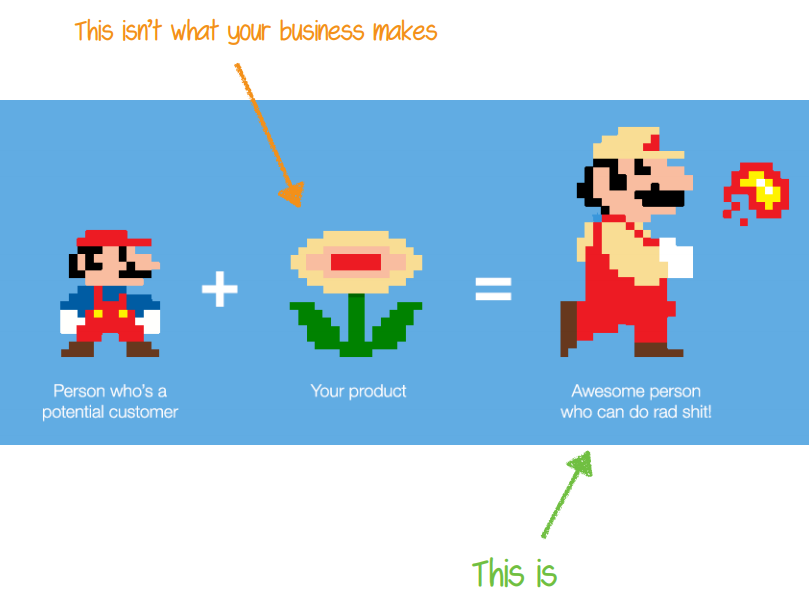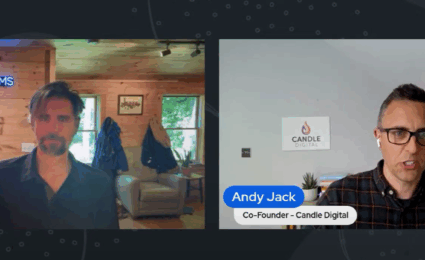What exactly are you selling?

We’ve often described learning products, such as online courses, as ‘a shortcut to an outcome’. The reason being that’s it’s rarely the experience of the course itself that a customer is after, it’s the transformation that has been promised as a result of it. And, more importantly, what this transformation means for how they now feel.
Here’s a great demonstration of this idea:

Source: useronboard.com
If you were an 80s kid like us, you’ll probably remember Super Mario well. As he went through the game, Mario had the opportunity to grab a load of goodies that gave him superpowers, which made the game a little easier, but also made it more exciting. The thrill didn’t come from collecting the item itself, it was what we could do as a result that mattered.
To help your product resonate with a potential customer, you need to think of it in the same way as a Mario power-up. Why?
It helps you tap into the emotional side of the purchase
It’s been said that all purchases are made with an emotional decision first, then justified rationally. So, to persuade people to buy, you need to appeal to their emotions and help them picture how they’ll feel after they’ve taken your course or used your product. This quote from Maya Angelou nicely summarises it:
“I’ve learned that people will forget what you said, people will forget what you did, but people will never forget how you made them feel.”
It allows you to get creative with your marketing
If you find yourself just listing a series of features where describing your product or service, you’re probably doing it an injustice. Selling a feeling gives you the chance to create some really evocative imagery in a person’s mind – try and get them to sense what the change will feel like. Ramit Sethi does a great job of tapping into the hearts and minds of potential online course customers in his email copy, and is worth signing up for his emails just for the copy alone.
It connects your product to the end goal
If you don’t do this, the potential customer has to make a leap, however small, to connect your product to what they’re trying to achieve. The hole and the drill is a commonly cited example of this. When someone buys a drill, they’re not buying it because they’re desperate to own a drill, but because they want to create a hole. So, in essence, when you’re selling a drill, you’re selling the outcome, not the product itself.
Seth Godin has riffed on this idea and even takes it a step further. He says the person who buys the drill also wants to feel proud of putting a shelf up by themselves and be able to show it off to their other half. It’s these feelings and desires that you need to try to tap into. But, teasing out the emotional reasons people buy your products can be difficult at first attempt.
Here’s how you can figure out what you’re really selling:
Talk to your customers
Seems an obvious one, but often overlooked! We’d advocate doing this for a multitude of reasons, but in this case, it can help explain the rationale behind their purchase and the change they hoped it would deliver. Ask them why they bought from you in the first place.
Review the feedback and comments you receive
Are there any recurring messages about how you’ve helped your customers? If you’re not getting a steady stream of feedback, it may be that your online course isn’t delivering the outcomes that it promised.
Work through a value proposition canvas
A value proposition canvas is a good way to tease out some of the problems your customers are looking to overcome. This can then help you devise an online course or digital product that solves them. If you already have an online course or product, it can also help you check you’re actually solving your customers’ pain points.
Test out your marketing messages
Draft some different marketing messages and put them in front of potential customers. See which one strikes a chord and which gets the best reception. If you already have a good number of leads and sales enquiries, consider doing some A/B testing, then review your analytics to see which works better.
To wrap up, here are some pointers to think about:
- Have a look through your marketing and sales materials. How much of the copy simply describes the product and what it does, rather than how it will make your target customer feel after purchasing it, or, if it’s an online course, completing it?
- Have a go at filling out a value proposition canvas. What do you notice?
- Keep Super Mario in mind the next time you’re creating marketing content. Which superpower does your product give your customers?
Fresh Insights Direct to Your Inbox
Enjoyed this article?
Join the Candle Digital Mailing List
You’ve Mastered Your Craft. Now Scale It.









